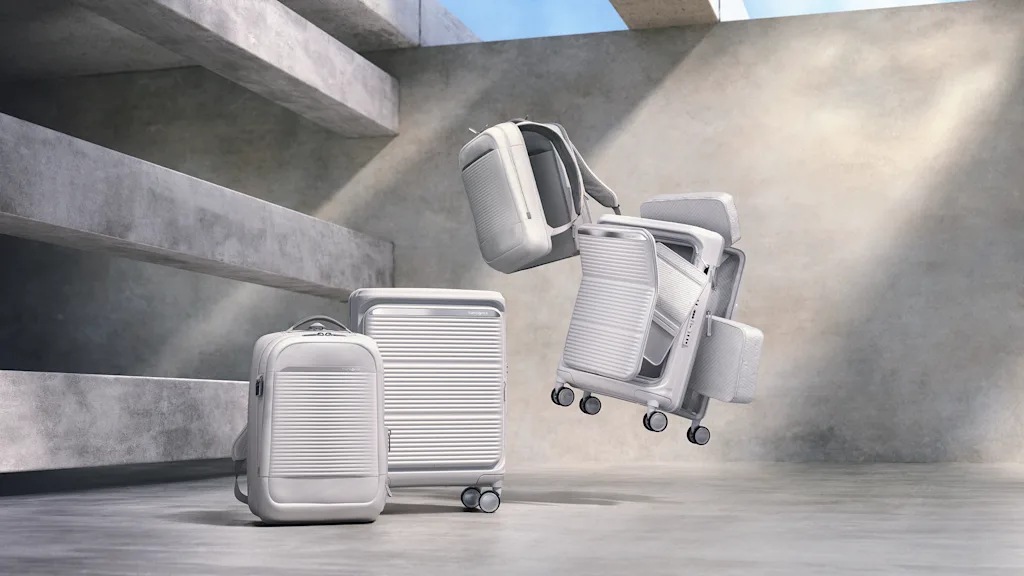
Samsonite, the world’s largest luggage brand, has just released a new suitcase design that’s an amalgamation of its best ideas from over its 115-year history. Named Paralux, it is lightweight yet hardshell, and its shell is made with 50% recycled polypropylene. “I want to think of it as our greatest hits album,” VP of design Ulliyada Bopanna told Fast Company.
But if Paralux is Samsonite’s greatest hits album, it also has a bonus track. The collection features something that neither Samsonite nor any other brand has ever experimented with before: The hardshell suitcase sports two openings—one in the middle (like most standard suitcases), and one at the front (like some soft-shell carry-ons).
The result is a dual-access suitcase that lets you access the full contents of your luggage by simply unzipping the front door in a cramped hotel room or when you’re navigating crowded airport terminals.
A suitcase with global appeal
Paralux is the product of a rare collaboration between Samsonite’s various design teams across New York and Asia. The collaboration is unusual because, as Bopanna explains, luggage needs vary drastically from one region to another. In Europe, for example, travelers prioritize lightweight designs, largely because of the strict weight restrictions associated with low-cost airlines such as Ryanair or Wizz Air. In the U.S., “it’s the exact opposite,” says Bopanna, adding that American travelers perceive lightweight luggage as weak and fragile.
Subscribe to the Design newsletter.The latest innovations in design brought to you every weekday
Privacy Policy
|
Fast Company Newsletters
These regional variances have meant that Samsonite often designs suitcases to meet the specific criteria of particular markets. But Paralux was intended as a global collection—one that could appeal to travelers across the world, especially those who have experienced, firsthand, the cramped quarters of hotel rooms in Asia.
The collection includes a dual-access carry-on (starting at $319), two spinners in medium ($369) and large ($409) sizes, plus a duffel ($169), and a versatile two-in-one backpack that lets you pack clothes in the main compartment, then unzip a separate day bag for quick trips ($199).
Engineering the impossible
Samsonite isn’t operating in a vacuum. Over the past decade or so, the luggage world has gotten crowded thanks to a parade of Instagram-ready startups that have turned suitcases into lifestyle statements. Away burst onto the scene in 2015 with sleek hard shells and built-in phone chargers, making $275 carry-ons feel aspirational. Then came Monos with its minimalist aesthetics, and Dagne Dover, which sought to make soft-side suitcases sexier.
For a 114-year-old giant like Samsonite, standing out in this design-obsessed market isn’t just smart—it’s survival. The brand, which commands nearly 20% of the luggage market with its brands including Samsonite, Tumi, and American Tourister, has seen its sales shrink in 2025. Net sales for the first half of the year are down 5.2%.
The Paralux suitcase offers a moment of renewed innovation. The suitcase recently won two Red Dot Awards for sustainability design and overall product design. It took three years to develop, and more than 20 prototypes to get right. “There’s a good reason why people aren’t doing it,” Bopanna says with a laugh. “It’s because it’s bloody tough.”
Unsurprisingly, the dual-access feature was the biggest challenge to solve, since any incisions in a hardshell compromise the structural integrity of the shell. “Adding a front door creates weakness,” says Bopanna. “For carry-ons, that’s not such a big deal, but once you look at large luggage, it starts to torque easily.”
advertisement
The designers couldn’t just make some parts of the suitcase thicker, because that would have made it heavier, eliminating some of the appeal for weight-conscious travelers. At 11.2 pounds, the large suitcase is among the industry’s lightest, though not the absolute lightest. The Samsonite team is aware of this trade-off as the original weight goal was even lower, but they ultimately compromised on weight in favor of durability.
Bopanna declined to share specific engineering details, but he noted that the entire design is meant to be self-reinforcing, including the parallel ridges on the front of the hardshell, which provide structural support. “If we’d chosen more robust materials or aluminum [which is heavier than polypropylene], it wouldn’t have been as difficult, but we made a conscious choice to take a step forward using recycled polypropylene,” he says.
Since virgin polypropylene is slightly stronger than its recycled counterpart, the team used a higher ratio of recycled material in the shell, and chose entirely virgin poly for the wheels, which take the most beating. The handles, meanwhile, are made of recycled aluminum. The team also made the handles and wheels easier to repair by reducing the number of screws; if one of them breaks, they can ship you a spare part that you can install yourself.
In the end, the Paralux collection exemplifies the brand’s broader approach to sustainability, which Bopanna describes as finding simple solutions to big problems. “Innovation doesn’t have to be big,” he says, “as long as you are solving a recurring problem, that to me is a great way to move the benchmark forward.”



